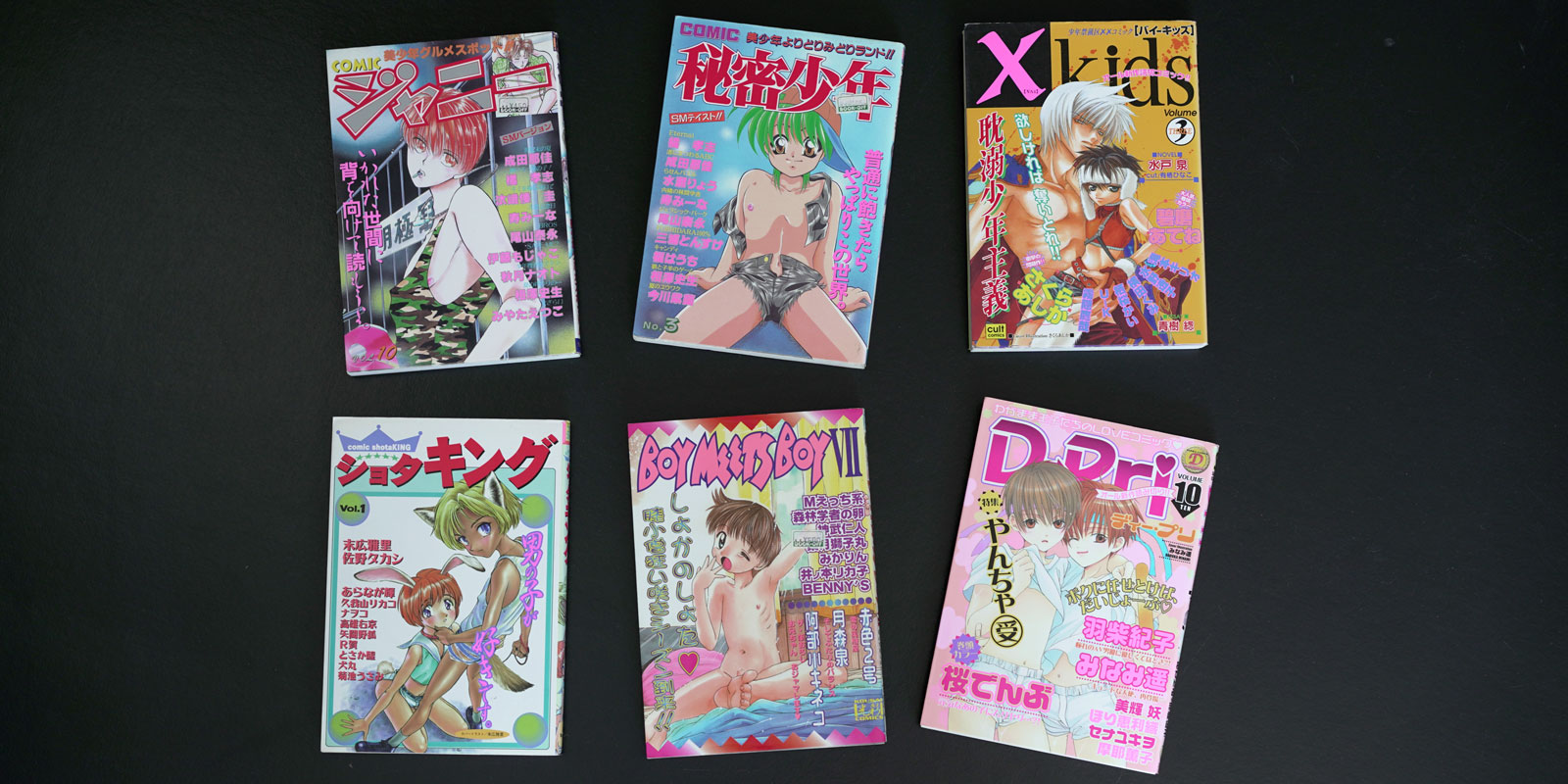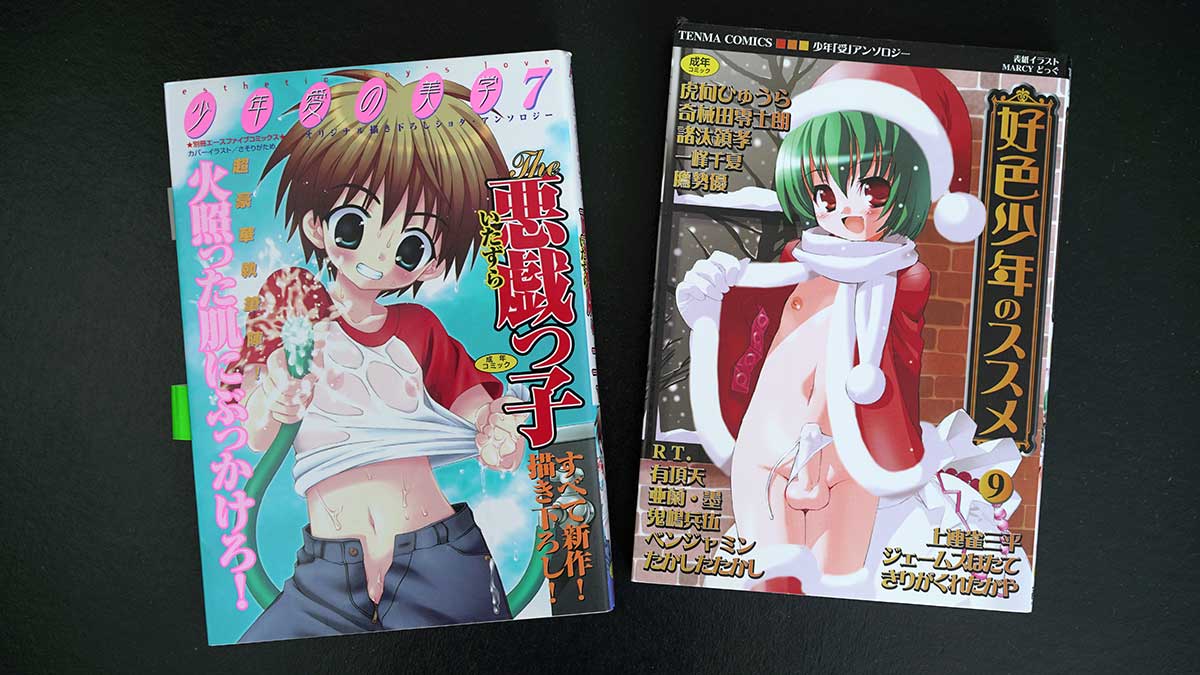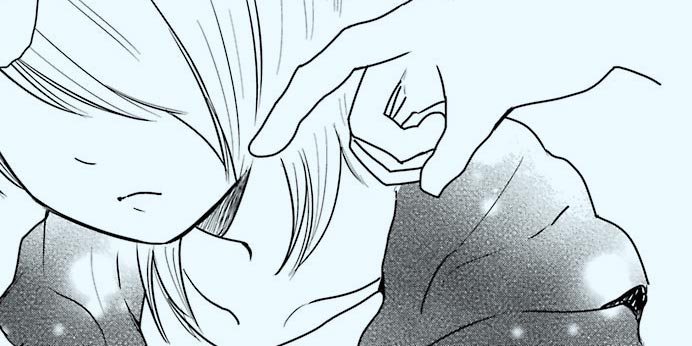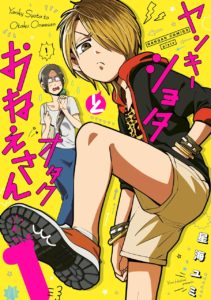This is an English summary of the second through fourth chapters of ショタコンのゆりかご (shotacon no yurikago = “the cradle of shotacon”) by shota researcher Budōuri Kusuko, published as a dōjinshi in 2007. Budōuri-san stresses that his essay only concerns commercial shota publications, not dōjinshi.
The rise of commercial shota
In the beginning, shortly after the term’s inception in 1981, “shotacon” referred to all kinds of boys, from 2D anime characters to 3D child actors.
The latter half of the 1980s saw the birth of exclusive shota anthologies. Following the boom of derivative yaoi works based on Captain Tsubasa, the first shota anthology つばさ百貨店 (Tsubasa Hyakkaten = “Tsubasa department store”) was launched in January 1987.
This kind of anthology contained various dōjinshi that had been selected to be published commercially. Several dōjinshi anthologies based on Captain Tsubasa, Saint Seiya, and Legendary Armor Samurai Troopers (Ronin Warriors) followed. They were soon joined by the characters from Mashin Eiyūden Wataru and Madō King Granzort, the former of which was pivotal for the shota genre’s breakthrough, as we have seen before:
Dōjinshi anthologies were followed by original anthologies, for which authors contributed original comics based on a certain theme. The anthology b-Boy 特集 ショタコン (b-boy tokushū shotacon = “special issue shotacon”) from October 1994 was important, since it was the first time the word “shotacon” appeared as a designation of the content on the cover.
Judging from the reader letters, Budōuri-san notes that there seems to have been little consensus at the time on what shotacon really meant.

In the 1991 edition of the annually published terminology dictionary 現代用語の基礎知識 (gendaiyōgo no kisochishiki ≈ “basic knowledge of contemporary terms”), shotacon was listed under yaoi, and described thusly:
ロリコンに対抗する少女たちの『少年趣味』をショタコン(正太郎コンプレックス)と、かつて呼んでいたが
The “boy hobby” of girls corresponding to lolicon is called shotacon (Shotarō complex)
In April 1995, TIP TAP became the first anthology series that focused entirely on shotacon. It was published by Eikō Publishing and had the subtitle “ショタコン ONLY アンソロジー” (“shotacon ONLY anthology”). Although TIP TAP was discontinued after the third issue, the boom of shotacon anthologies that followed would have been impossible without it, Budōuri-san writes.
It seems to me that Budōuri-san mourns what TIP TAP could have become. He notes that it seems to have been planned as a book-like magazine with serialisations, readers’ corner, and the like. My thoughts wander to Shōnen Jump. What if TIP TAP had become a Shotacon Jump that lived on, year after year, as the go-to authority of shotacon expression? Instead, we got a scattered stream of one-shots from publishers hoping to make a buck on the new genre, like a gold rush, or in this case: A boy rush. Which eventually faded, as we shall see.
The decline of commercial shota
Several “shotacon only” publications were founded by major publishing companies in the wake of TIP TAP’s 1994 launch:
- 1995: テディボーイ (Teddy Boy), a “shotacon only anthology” (Takeshobo)
- 1996: ROMEO, with the English slogan “WE are SHŌTARO COMPLEX” (Naito Issuisha)
- 1997: COMIC厨子王 (Comic Zushi-ō = “comic prince”) (Shobunkan)
Other publications didn’t mention “shotacon” explicitly, but experimented in the new genre in a way that Budōuri-san aptly calls “trial and error”. An example would be U.C.Boys from the major adult publisher Akane Shinsha, which claimed to be “a book with boys, by boys, for boys” (“男の子による男の子のための男の子本”).
Published over three and a half years, ROMEO was the most long-lived of the new magazines. It had a bustling reader section.

Budōuri-san next turns to Manda Ringo’s unique book The Syotaroh from 1996, where he notes a divide between male and female shota fans in how they think about shota and sexuality. He also notes what I understand as an unreflected optimism from Ringo’s side, which in retrospect turned out to be unfounded. (I think this is true also for Watanabe Yumiko’s essay ショタの研究 – shota no kenkyū = “shota research” – from 1998. It is telling that both texts were published in the latter half of the 1990s, right in the middle of the commercial shota boom.)
A new law on child pornography was passed in 1999. I’m trying to understand from the text if there was a relation to the publication Pet‐BOY’s, with the English log line “SHOTA‐COM COMIC ANTHOLOGY”, which was launched in October 1997 and became something of a sensation with its explicit adult expressions. In any case, by the end of 1999, most commercial shota anthologies had ceased publication.
Following the mass death of shota publications in 1999, there was a black hole of nothingness for about two years, at least in regards of commercial and exclusive shota publications. During this time, shota expressions lived on in subsections of other magazines.
The next shota wave
In 2002, the next shota wave was initiated with the publication of ショタコミ (shotacomi) by Shobunkan. The editors stated clearly the purpose of the magazine:
ショタコミック誌の再興を目指し立ち上がった「ショタコミ」
We launched Shotacomi to revive the shota comic magazine.
Other shota titles followed in 2003, which unlike Shotacomi had the “adult comic” mark:
- 好色少年のススメ (kōshoku-shōnen no susume ≈ “boy desire digest”) from Akane Shinsha
- 少年愛の美学 (shōnen-ai no bigaku ≈ “boys’ love aesthetics”) from Shobunkan
- 少年嗜好 (shōnen shikō ≈ “boy taste”) from Ōtōshobō (nowadays Oakla Publishing)

It seems Shotacomi split into 少年愛の美学 and 妄想少年 (mōsō-shōnen ≈ “boy delusion” or “delusional boys” – I discuss the term mōsō here). Budōuri-san notes that these publications seem more aware of their controversial content, as both state that no character is underage.
Shobunkan played an important role in the new wave of shota publications, not least when they started publishing books whose existence was not dependent on an “adult comics” mark (unlike magazines?). This trend, which other publishers soon followed, started with ショタコミ Collection (shotacomi collection).
Non-sexual (or less sexual) BL anthologies evaded the “adult comic” mark. One example is X kids, published by Kasakura from 1998 to 2005.
As shotacon became a more well known phenomenon, the definition in 現代用語の基礎知識 explanded over the years. Whereas the 1997 version equaled a shotacon with “a woman interested only in boys, as well as such a hobby”, the 2000 edition had expanded the definition of shotacon to both sexes:
少年にしか興味を示さない人。そのような趣味。ショートアイズ・コ ンプレックスから。両目の間が近い子どもを指す俗語。
A person interested only in boys, as well as such a hobby. From “short eyes complex”, a slang term denoting children with close-set eyes.
(So they got the etymology wrong, despite it was Comiket director Yonezawa Yoshihiro who was in charge for manga terms.)
The end of the next shota wave
Both 少年愛の美学 and 好色少年のススメ published their last issues in 2006. 少年嗜好 continued publishing but has gradually become more focused on 女装 (josō ≈ cross-dressing). The editor of 少年嗜好 is also involved in 男の娘HEAVEN (otoko-no-ko heaven), which is focused on the cross-dressing shota genre otoko-no-ko.
Budōuri-san concludes that commercial shota expressions keep changing, maybe as a way to adapt and survive on a market where the readers’ taste differ widely. The first and the second shota wave differed in that regard, and dōjinshi have kept widening the readerbase since 2002.
So in conclusion, Budōuri-san has documented two waves of commercial shota magazines, from 1994 to 1999, and from 2002 to 2006. Since the chapters were written in 2006 and 2007, the natural question is what has happened on the shota market since then.



